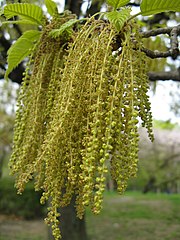Wind-pollination (anemophily) syndrome
The flowers of wind-pollinated flowering plants, such as this saw-tooth oak (Quercus acutissima), are less showy than insect-pollinated flowers.
Anemophilous plants, such as this pine (Pinus) produce large quantities of pollen, which is carried on the wind.
Anemophily or wind pollination is a form of pollination whereby pollen is distributed by wind.[1] Almost all gymnosperms are anemophilous, as are many plants in the order Poales, including grasses, sedges, and rushes.[1] Other common anemophilous plants are oaks, pecans, pistachios, sweet chestnuts, alders, hops, and members of the family Juglandaceae (hickory or walnut family).[2] Approximately 12% of plants across the globe are pollinated by anemophily, including cereal crops like rice and corn and other prominent crop plants like wheat, rye, barley, and oats.[3] In addition, many pines, spruces, and firs are wind-pollinated.[2]
- ^ a b A. K. Shukla; M. R. Vijayaraghavan; Bharti Chaudhry (1998). "Abiotic pollination". Biology Of Pollen. APH Publishing. pp. 67–69. ISBN 9788170249245.
- ^ a b Resources, University of California, Division of Agriculture and Natural. "Wind". ucanr.edu. Retrieved 2020-12-01.
{{cite web}}: CS1 maint: multiple names: authors list (link) - ^ "Wind Pollination". seeds.ca. Retrieved 2020-12-15.

